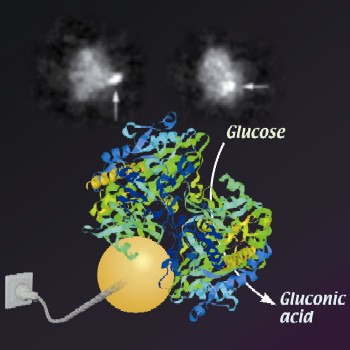Future application: sensors for more effective treatment of diabetic patients * The new study by scientists from the Institute of Chemistry at the Hebrew University of Jerusalem, led by Prof. Itamar Willner and in collaboration with the National Research Institute in Brookhaven, USA was published in the latest issue of the prestigious magazine Science

In the figure: implantation of a gold nanoparticle in a protein and its electrical activation (above: a microscope image of the protein containing the nanoparticle marked with an arrow).
Direct link to this page: https://www.hayadan.org.il/nanogold1.html
A new study by the scientists of the Institute of Chemistry at the Hebrew University, led by Prof. Itamar Willner, in collaboration with the National Research Institute in Brookhaven, New York, USA, may lead to the development of effective sensors that will improve the treatment of diabetes patients. The innovative research based on nanotechnological knowledge was published in the prestigious magazine Science.
Nanometric-sized particles, (that is, billionths of a meter in size), which are the building blocks of the science of nano-technology, and natural proteins from animals and plants have similar dimensions, which enables a connection between the components to produce a hybrid material with new properties. In the new study, the scientists succeeded in implanting a 1.2 nanometer gold nanoparticle into the glucose oxidase enzyme.
According to Prof. Wilner from the Institute of Chemistry at the Hebrew University: "The enzyme glucose oxidase, like many other enzymes, acts as an isolated substance when it is connected to the electrode. On the other hand, immobilizing the enzyme when it contains a gold nanoparticle implanted in a protein on the surface of an electrode enables efficient electrical communication between the enzyme and the electrode."
When an electric voltage is applied to the electrode, electrons flow from the enzyme to the electrode, and the enzyme is activated to oxidize the glucose in the solution. The electrical current in the system corresponds to the glucose level in the solution. The gold nanoparticle implanted in the protein acts as a "socket-plug" structure, allowing the flow of electrons from the enzyme to the electrode and activation of the biological material.
This new technique of enzyme immobilization allows measurement of the blood glucose level with higher sensitivity and accuracy. According to the researchers, the new bioelectrodes may be used in the future as miniaturized devices that will act as sensors to detect the glucose level in diabetics. In addition, it will be possible to create intracorporeal biological fuel cells, which enable the generation of electrical energy from blood sugar to operate pacemakers or insulin pumps, and to develop enzymatic electrode arrays to heal wounds in diabetics.
Nanotechnology connoisseur
https://www.hayadan.org.il/BuildaGate4/general2/data_card.php?Cat=~~~534317089~~~191&SiteName=hayadan
